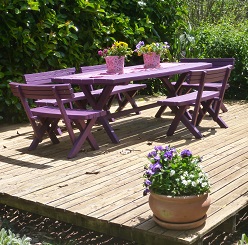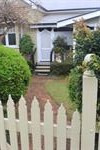Using Timber in a Garden
 Timber looks great in the garden and it’s versatile. You can construct just about anything from timber - from a shed or deck to a wall or wheelbarrow. If time isn’t a problem, it’s cheap too – you can grow your own!
Timber looks great in the garden and it’s versatile. You can construct just about anything from timber - from a shed or deck to a wall or wheelbarrow. If time isn’t a problem, it’s cheap too – you can grow your own!
Winter is a great time to tackle a backyard construction project. If you live inland or up north, the weather is likely to be dry and sunny – ideal conditions for building a retaining wall, a deck or any other major construction work that involves heavy lifting and long hours outdoors.
Down south, if the weather’s bad, you can retreat to your shed or workshop and try your hand at a smaller project such as a garden bench or planter box.
WHICH TIMBER?
Timber is an organic material. It can shrink, swell and change colour in response to environmental conditions, and it can be prone to damage from pests and wood rots.
Some timbers are more weather or pest resistant than others. Timber that is vulnerable to termites, borers and fungal rots should be raised off the ground or treated before going outdoors. If you live in a termite prone area, then treat your timber before it goes near the ground.
- Timbers suitable for contact with the ground include jarrah, merbu, river red gum and turpentine.
- Timber that can be used outdoors without being painted includes celery top pine, brush box, jarrah, kapur, river red gum and stringybark.
- Other timbers used outdoors but which need some protection (eg. painting or preservative) include radiata pine, redwood, western red cedar, blue gum and tallow wood.
- If you are uncertain whether your timber is weather and pest resistant, treat it with preservative.
CHOOSING A PIECE OF WOOD
There are many things to consider when choosing timber for work in the garden.
THE TYPE OF TIMBER
- Is it strong enough to support the load it is expected to carry?
- Is it suitable for outdoor use?
- Will it need to be treated?
- Does it look good?
TIMBER QUALITY
- Does it have straight grain?
- Are there many knots in the wood?
- Are there splits, chips or other damage in the wood?
MOISTURE CONTENT
It is always preferable to buy cured or ‘seasoned’ timber. Dried timber is stronger than freshly cut wood. Timber that is bought while green can split, buckle or crack later.
TIMBER STRENGTH
The strongest wood comes from heartwood or inner wood of a tree. The strength of this timber is determined by the density of the dead plant cells that make up the wood. In other words, the closer the tree rings, the stronger the timber.
Timber strength is affected by the angle of the cut into the tree log. Wherever possible, choose timber that has been cut lengthways, as this will be the stronger wood.
How timber is dried also has an effect on its overall strength. If it is dried gradually, it will become stronger than similar timber that is dried quickly in a kiln. In Australia timber strength is classified into twelve different grades, eg. F5, F8, etc. The higher the ‘F’ number, the greater the strength.
DRESSED TIMBER
Timber that is ‘dressed’ has been sanded or planed to form smooth surfaces.
 WHAT IS THE DIFFERENCE BETWEEN SOFTWOOD AND HARDWOOD?
WHAT IS THE DIFFERENCE BETWEEN SOFTWOOD AND HARDWOOD?
- Softwood timbers come from conifer trees like pine, cypress and oregon. They mark easily, but are much easier to work with and are often cheaper to buy. Although some softwoods are more susceptible to rotting and termites, new treatment methods mean that softwoods are now extensively used for structural timbers. Most softwoods are grown in plantations, so using these timbers reduces the damage to our native forests.
- Hardwood timbers come from tropical trees as well as wattles, maples, etc. In Australia, most hardwood comes from Eucalyptus trees. Hardwoods are more difficult to cut, drill and nail, but their timber is usually denser and they are more likely to resist pests or rotting.
TERMITES
With restrictions on the use of hazardous termite control chemicals, the incidence of termites have greatly increased. There is a big risk in many parts of Australia, and some other countries; but if you understand what termites like and dislike, you can minimise your risk of having A SERIOUS ATTACK.
Termites are especially attracted to timber that is damp and infested with wood-decaying fungi. Proper site preparation, the use of termite resistant wood/ timber preservatives and the prevention of dampness will deter termites.
Don’t think that railway sleepers will not be attacked because they are soaked with oil. Termites often make nests in sleeper walls.
Termites are more likely to nest in timber that is in contact with the soil…but they can enter a building, timber seat or wooden pergola higher up as well.
Concrete slab-on-ground construction is the most common type of construction, but is susceptible to termite entry. Concrete slabs retain moisture under them, and attract termites. Make sure there are no cracks in the slab, as cracks will allow termites access to your timber framework.
PRESERVE YOUR WORK
There’s nothing more disheartening than putting a lot of work into building something and having it rot or be eaten away.
Make sure you are either using a weather and pest resistant timber; or you have treated it before exposing it to the weather and termites.
Preservatives
Timber preservatives work by either sealing the surface or soaking into the timber, or a combination of both. This discourages fungal rots and insects from feeding on the wood. There are all sorts of preservatives available:
- Oil-based paints are a popular way to preserve timber without losing the look and texture of the wood. Some oil paints include colouring that can actually enhance the appearance of the timber. Paint is not as effective as some other timber preservatives, and it will usually be necessary to recoat the wood every few years.
- Bitumen based products such as Creosote are effective, but they are black, flammable and smelly.
- CCA is used to treat pine and other softwoods. It is made from copper, chrome and arsenic, and gives timber a characteristic grey-green colour. Once applied, it will not leach from the timber. CCA treated timber will produce toxic fumes if it is burnt.
- Copper preservatives will prevent fungal disease.
If you are using timber preservatives, be careful. Wear a mask and gloves, as some of these chemicals can be toxic.
KEEPING TIMBER OFF THE GROUND
If you are using timber that is vulnerable to attack from termites and rot, then you must keep the timber off the ground.
Supporting posts can be kept off the ground by setting them into a galvanised steel saddle. This saddle is in turn supported by a concrete footing.
If you are building a fence, use rot-resistant timbers for the posts and then include a plinth below the vertical timbers. This piece of timber will be the only one that is exposed to soil. If it rots, it can be replaced without having to replace the whole fence.
USING TIMBER IN THE GARDEN
Timber structures have a natural appeal, and will blend easily in any style of garden. Some of the popular ways to use timber outdoors include:
- decks
- steps
- pergolas and outdoor rooms
- arches and arbours
- sheds
- fencing – paling, picket, post and rail
- retaining walls
- garden edging
- outdoor furniture – tables, benches, garden seats
- ornaments – planter boxes,
- play structures – swing frames, climbing frames, sandpits
- compost bays
- letterboxes
RECYCLED TIMBERS
You don’t have to buy brand new timber to use in your garden. Second-hand timbers can not only look good, they are often stronger than recently cut wood. Using recycled timbers also reduces the need to cut down trees.
Used railway sleepers have been a popular material for retaining walls and steps for many years. Used telephone poles can be used for garden borders and climbing frames. Recycled timbers can be much cheaper than new timber.
RADIALLY SAWN TIMBER
Some timber merchants have recently adopted the practice of sawing timber radially. This type of milling produces a rustic finish and wastes very little of the log compared to conventional milling. The timber is can be used to construct all kinds of garden features such as fences, decks and pergolas.
You may also be interested in....